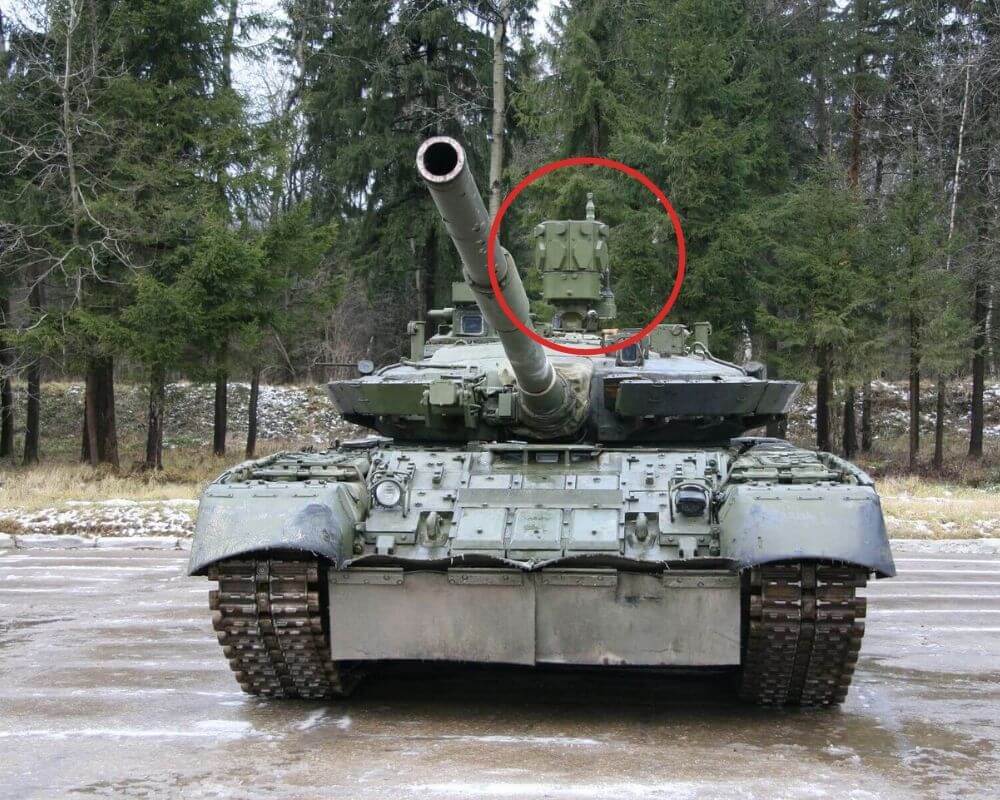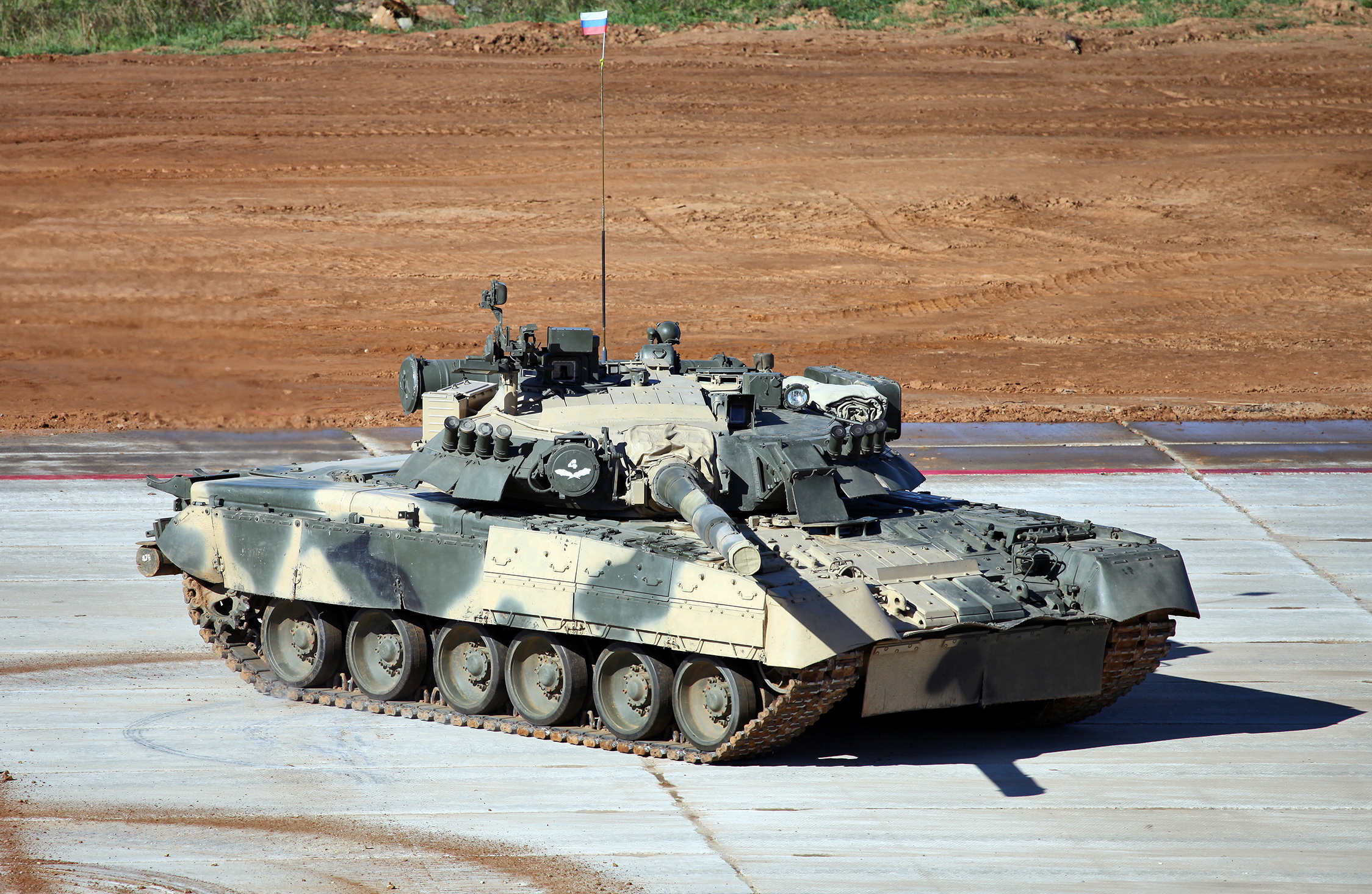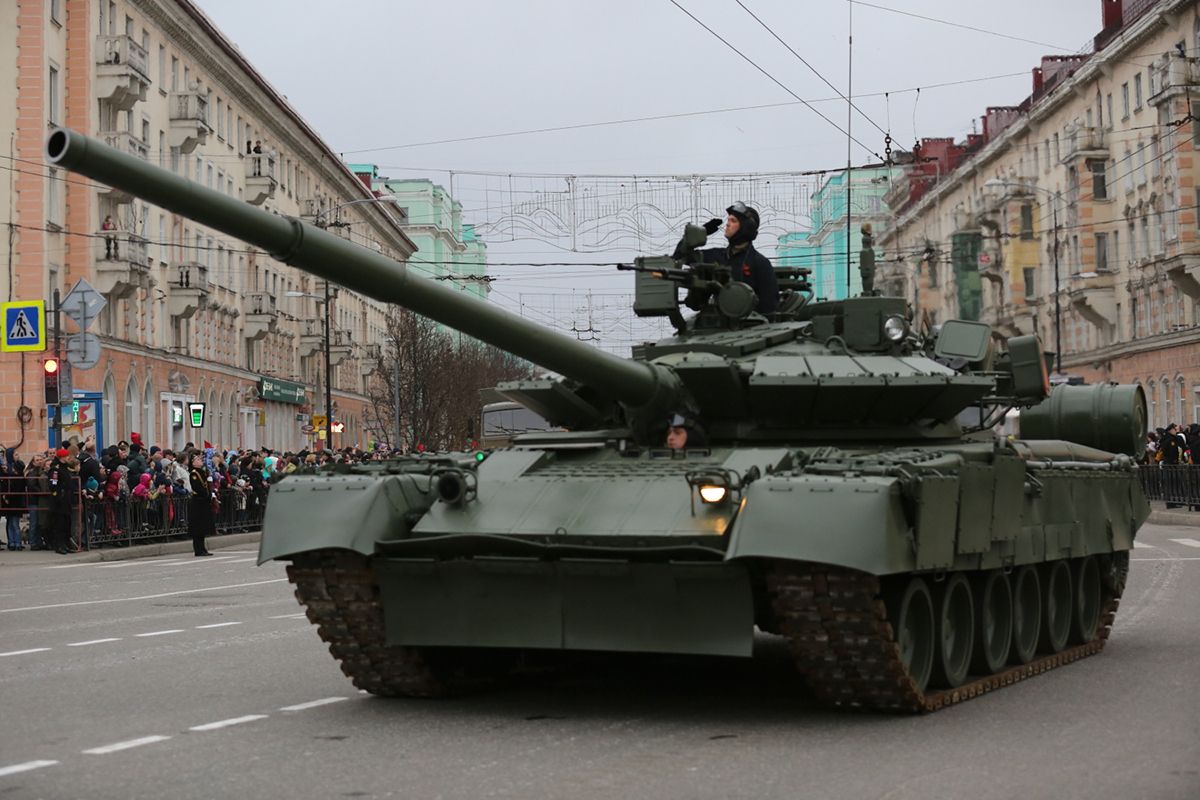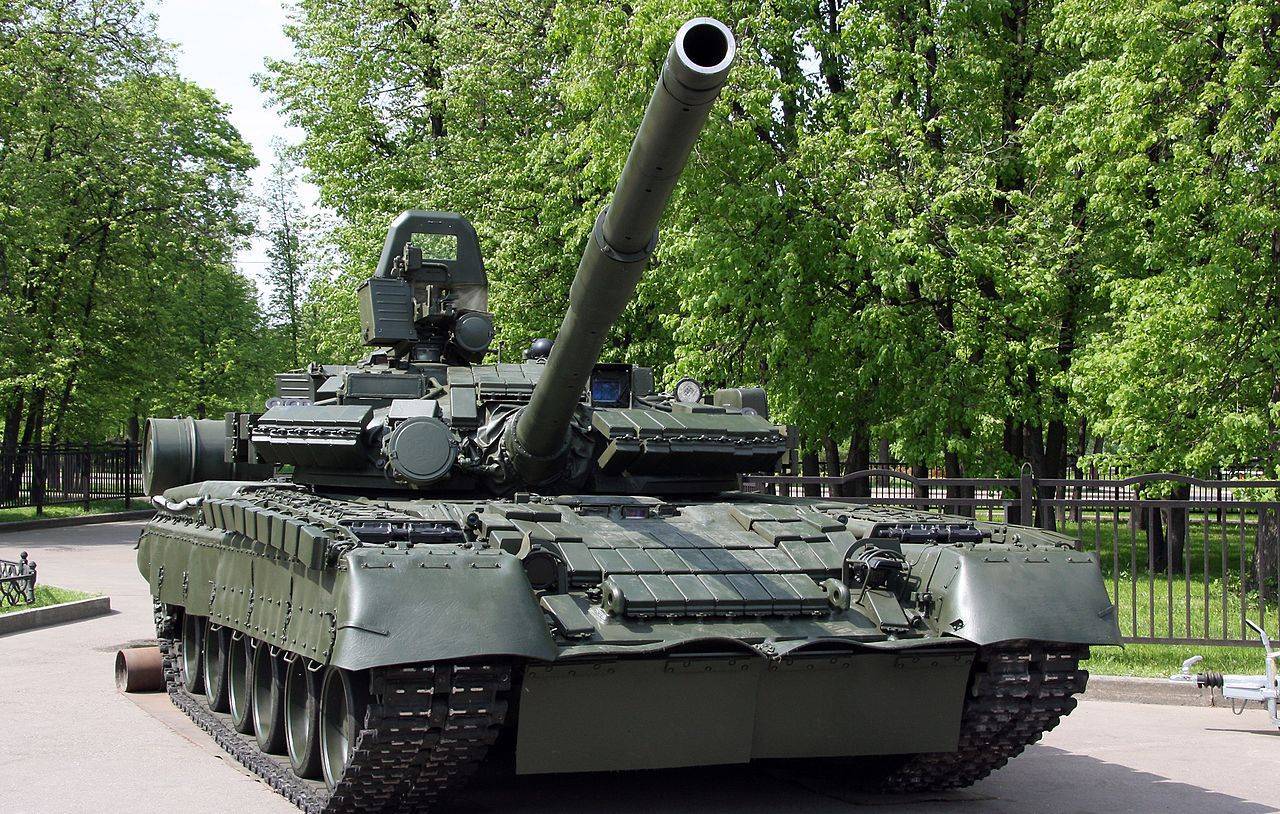T80 Tank Cost - The T-80 is a Russian tank designed in the Soviet Union and entered service in 1976. The T-80 was a further development of the T-64. The T-80 was the world's first production tank to have a gas turbine as its main propulsion. The chief engineer of the T-80 was Russian engineer Nikolai Popov.
The T-80 was co-designed by the Kirov Factory in St. Petersburg and manufactured by Omsk-based Transmash. The tank's main armament is a 125 mm smoothbore gun and an automatic loader. The Russian military has had experience with the Charger since the mid-1960s, and it's a proven concept. In addition to normal ammunition, the gun can fire anti-tank guided missiles. The tank was also equipped with a laser range finder, which increased the hit rate. The driver's compartment is located in the front center of the tank. In a two-man turret, the gunner sits on the left and the commander on the right. The engine was a 1000 hp gas turbine, but later versions were equipped with more economical diesel engines that were also easier to maintain. The gearbox has five forward gears and one reverse gear. The maximum speed on the road is 70 km/h and 43 km/h on the terrain. With regular fuel tanks of 1100 liters, the range is 335 km.
T80 Tank Cost

The T-80 and its variants are still in service in Belarus, Cyprus, Kazakhstan, Pakistan, Russia, South Korea and Ukraine. T-80U and T-80UM modifications are currently in production in Omsk. An advanced derivative, the T-84, is still produced in Ukraine. The latter is a further development of the T-80UD with a 1200 hp diesel engine and a modified gun turret.
New T 80 Tank Modernization Projects
In 1997, a new tank was announced, the Zwarte Arend, with an extended chassis of the T-80U and a new turret with a new gun and a new loading system. No one was in the tower as toxic gases were released. The project was discontinued and the new tank T-14 Armata was already in production.
T-10 T-54 T-62 T-72 T-80 T-90 PT-76 T-95 Black Eagle T-14 Armata
M-1973 M-1974 ASU-57 BM-21 BM-24 BM-27 BM-30 SA-22 9K37M1-2 Buk-M1-2 The Russian T-80 tank is the 2nd generation main battle tank currently in service. Russian military and exported to a small number of countries.
The T-80 was developed as a replacement for the troubled T-64 tank series. The T-80 was considered a more advanced main battle tank than the cheaper T-72 and was built in smaller numbers.
Amazon.com: Rpg35001 1:35 Rpg Model T 80u Russian Main Battle Tank [model Building Kit]
It has a crew of 3, has the autoloader concept of the T-64 and T-72, is armed with a 125 mm smoothbore main gun and has a powerful gas turbine engine.
After T-80 tank losses in the First Chechen War, the maintenance costs of running the gas turbine engine, T-80 production ceased.
Instead, its technology was implemented in an upgrade of the T-72, resulting in the T-90 in service with the Russian Army.

The T-80 tank's upgraded Kontakt-5 armor and ATGM capability were of great concern to some NATO tank crews.
Russian And Ukrainian Forces Suffer Unsustainable Casualty Rates
The T-80 uses a 125mm smoothbore main gun. It was a version of the 2A46 series and was upgraded in later T-80 models. It can fire anti-tank guided missiles through the main gun like Cobra and Reflex.
The T-80 uses an autoloader similar to the T-72, with 2-part ammunition stored in rotating magazines on the turret floor. The mechanism loads both halves of the round directly into breach 1 at once.
We had one coaxial machine gun installed as standard with an additional large caliber machine gun mounted on the commander's cupola. It can be rotated and raised to fire from inside the dome.
The T-80 has a fixed gunner's day sight and a secondary night sight. This was upgraded in later T-80 models with infra-red and later thermal imaging.
Development] T 80u: Making Contact
Like most Russian main battle tanks, the T-80 has a small and low profile compared to Western tanks. In front of the hull driver is a long sloping upper glacier. This has been enhanced with a laminated shield welded to the front under the upgraded models.
The tower is circular in shape. The basic composite fairing is at the front and has been enhanced during its upgraded models, leaving a visible lip at the bottom.
The T-80 tank is equipped with explosive reactive armor. It consisted of Kontakt-1 and Kontakt-5 ERA blocks mounted on the front and top, upper glacis plate and turrets at the front of the hull.
A key feature of the T-80 tank was the use of a gas turbine engine, which eventually sealed its fate in the Russian army. The decision to use a gas turbine engine was based on increased performance compared to a conventional piston engine of the same size.
Meet Russia's Most Advanced Tank (and Why The Us Army Isn't Worried About It)
The T-80 was the world's first mass-produced tank with a gas turbine engine (3 years later by the M1 Abrams). This gave the T-80 tank unmatched mobility and off-road speed for a relatively small main battle tank and improved vehicle survivability compared to other Russian tanks.
The only disadvantage of using a gas turbine engine is the high fuel consumption, which results in a short operating range. The vehicle used torsion bar suspension, a manual gearbox and had optional external fuel tanks on the rear hull.
The original T-80 model was developed as a replacement for the T-64, but it co-existed with the T-64 in subsequent upgrades incorporating many of the upgrades developed for the T-64 series. Russia has been toying with the concept of a gas turbine engine for a tank since the 1950s.
About 60 pilot tanks were built in 1968-71 and tested various combinations of suspension and sub-components. Trials continued until 1974 and while the improved mobility offered by the gas turbine engine proved popular, its high fuel consumption, short life and reduced operational range raised some concerns.
T 80 Standard Tank (ebook), Steven J. Zaloga
Despite these problems, due to the lack of improvements over the T-64 series in terms of ammunition and protection, production began in small numbers in 1976 until the improved production model "T-80B" was ready.
The Russian T-80B tank was the first major upgrade of the T-80 tank and the most common production model built. These include improvements in firepower such as the ability to fire a radio-guided anti-tank missile and improvements in vehicle armor.
After the Israeli Defense Forces successfully used Blazer Explosive Reactive Armor in the 1982 Lebanon War and saw the new armor's ability to defeat shaped charge weapons (HEAT), Russia developed its own era known as "Kontakt". It later became known as Kontakt-1 or Kontakt-5 ERA after development.

LKZ began production of the T-80B in 1985 with Kontakt, now known as the T-80BV (Vyzryvnoi - Explosive in English).
The Russian T 80 Tank
The Russian T-80U tank is the 3rd production model of the T-80. New Turret, 1250hp Engine, Kontakt-5 Explosive Reactive Armor & Reflex ATGM if available.
The command version of the T-80U, which has additional radio equipment, a land navigation system, but most notably the Shtora "soft-kill" active protection system. It mounts x2 laser jammers on the front of the turret.
The gas turbine engine concept was popular in some respects in terms of mobility, but had a negative effect on fuel consumption and engine life. There are several projects experimenting with diesel engines as an alternative to the gas turbine. The Ukrainian manufacturer of the T-80U (Kharkov) built their own version using their own multi-fuel, two-stroke turbo-piston 6TD-1 6-cylinder diesel engine, which produced 1000 hp. The T-80UD would evolve into the T-84.
Export model offered by Omsk (manufacturer of T-80) before bankruptcy. It features the Arena "Hard-Kill" active protection system. The Arena has the ability to detect incoming threats such as an ATGM and send a projectile into the threat's path to destroy it. The vehicle is in the demonstration phase and has not been exported.
Russia's Tanks In Ukraine Are Old, Obsolete And Failing
Another export model featuring the old Drozd "hard-kill" active protection system. The vehicle is in the demonstration phase and has not been exported.
2 mock-ups of the Object 640 Black Eagle tank were built based on the T-80U hull. It has 125mm main gun, autoloader, Kaktus ERA & Arena active protection.
Greece - Tried against several other tanks, including the Challenger 2, Leclerc and Leopard 2, which was the eventual winner.

Russia - A total of 4907 T-80 tanks in service in 1991, mostly T-80B & T-80BV. This number has decreased with the purchase of T-90A. In 2017 it was announced that Russia would remove a large number of T-80B/T-80BV from storage and upgrade them.
T80 Bvm Armor Vs M1a2 Armor
South Korea – 43 vehicles delivered in batches. Initially, the x33 was delivered in 1996-97 and the x10 in 2005-06.
Ukraine - 350 T-80UD tanks remained in the manufacturer's warehouse after the fall of the Soviet Union. Some stayed in Ukraine and some were exported to Pakistan. It was designed and manufactured in the former Soviet Union and manufactured in Russia. The T-80 was based on the T-64, but incorporated features from the later T-72. Chief designer of the T-80
Well tank replacement cost, tank t80, septic tank cleaning cost, t80 light tank, cost tank, septic tank service cost, t80 tank for sale, septic tank cost estimate, t80 russian tank, septic tank repair cost, turf tank cost, oil tank remediation cost
0 Comments